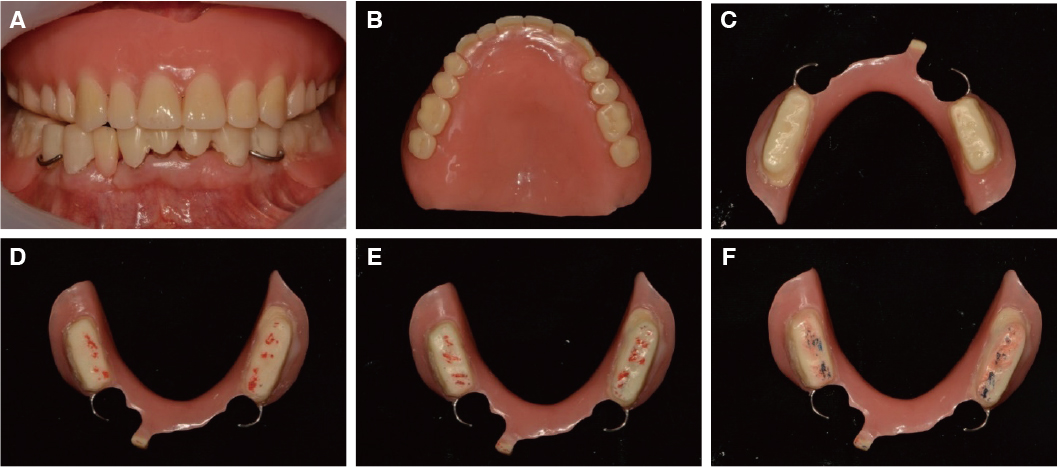J Korean Acad Prosthodont.
2020 Jan;58(1):35-41. 10.4047/jkap.2020.58.1.35.
Full mouth rehabilitation using removable prosthesis of patient with unstable mandible movements: A case report
- Affiliations
-
- 1Department of Prosthodontics, Section of Dentistry, Seoul National University Bundang Hospital, Seongnam, Republic of Korea. jdw@snubh.org
- KMID: 2469919
- DOI: http://doi.org/10.4047/jkap.2020.58.1.35
Abstract
- Patients with collapsed occlusal support and unilateral chewing show parafunctional mandibular movements, which can be complicated in older patients. Gothic arch tracing and split cast technique are used to confirm the deviation between centric relation and anterior habitual bite in patient who has oral dyskinesia and collapsed occlusion. Temporary denture as occlusal stabilization appliance was provided for stable occlusion and reproducible mandibular movement. Definitive denture was fabricated by lingualized occlusion concept.
MeSH Terms
Figure
Reference
-
1. Turner KA, Missirlian DM. Restoration of the extremely worn dentition. J Prosthet Dent. 1984; 52:467–474.
Article2. Rivera-Morales WC, Mohl ND. Relationship of occlusal vertical dimension to the health of the masticatory system. J Prosthet Dent. 1991; 65:547–553.
Article3. Blanchet PJ, Rompré PH, Lavigne GJ, Lamarche C. Oral dyskinesia: a clinical overview. Int J Prosthodont. 2005; 18:10–19.4. Viswanath A, Gordon SM. Two cases of oromandibular dystonia referred as temporomandibular joint disorder. Grand Rounds. 2012; 12:1–5.
Article5. Dawson PE. Centric relation. Its effect on occluso-muscle harmony. Dent Clin North Am. 1979; 23:169–180.6. Kantor ME, Silverman SI, Garfinkel L. Centric-relation recording techniques-a comparative investigation. J Prosthet Dent. 1972; 28:593–600.
Article7. Wojdyla SM, Wiederhold DM. Using intraoral Gothic arch tracing to balance full dentures and determine centric relation and occlusal vertical dimension. Dent Today. 2005; 24:74–77.8. Parker HM. Effective management of laboratory procedures and use of split-cast technique. J Prosthet Dent. 1974; 31:325–342.
Article9. Scandrett FR, Hanson JG. Technique for attaching the master cast to its split mounting index. J Prosthet Dent. 1978; 40:467–469.
Article10. Michelotti A, Silva R, Paduano S, Cimino R, Farella M. Oromandibular dystonia and hormonal factors: twelve years follow-up of a case report. J Oral Rehabil. 2009; 36:916–921.
Article11. Scott BL. Evaluation and treatment of dystonia. South Med J. 2000; 93:746–751.
Article12. Balasubramaniam R, Ram S. Orofacial movement disorders. Oral Maxillofac Surg Clin North Am. 2008; 20:273–285.
Article13. Goldman JG, Comella CL. Treatment of dystonia. Clin Neuropharmacol. 2003; 26:102–108.
Article14. Clark GT, Stiles A, Lockerman LZ, Gross SG. A critical review of the use of botulinum toxin in orofacial pain disorders. Dent Clin North Am. 2007; 51:245–261.
Article15. Tan EK, Jankovic J. Treating severe bruxism with botulinum toxin. J Am Dent Assoc. 2000; 131:211–216.
Article16. Ryu JW, Yoon CL, Cho YG, Ahn JM. Clinical manifestations in orofacial movement disorders. J Oral Med Pain. 2008; 33:375–382.17. Becker CM, Swoope CC, Guckes AD. Lingualized occlusion for removable prosthodontics. J Prosthet Dent. 1977; 38:601–608.
Article18. Carlsson GE. Symptoms of mandibular dysfunction in complete denture wearers. J Dent. 1976; 4:265–270.
Article
- Full Text Links
- Actions
-
Cited
- CITED
-
- Close
- Share
- Similar articles
-
- Full mouth rehabilitation of mandibular edentulous patient using implant hybrid prosthesis
- Full mouth rehabilitation of mandibular edentulous patient using implant hybrid prosthesis
- Full mouth rehabilitation utilizing implant-assisted removable partial denture with a canted occlusal plane: a case report
- Full-mouth rehabilitation with implant-supported fixed dental prostheses for the edentulous maxilla and partially edentulous mandible: A case report
- Full mouth rehabilitation of the patient with severely worn dentition using monolithic zirconia prosthesis: A clinical report











